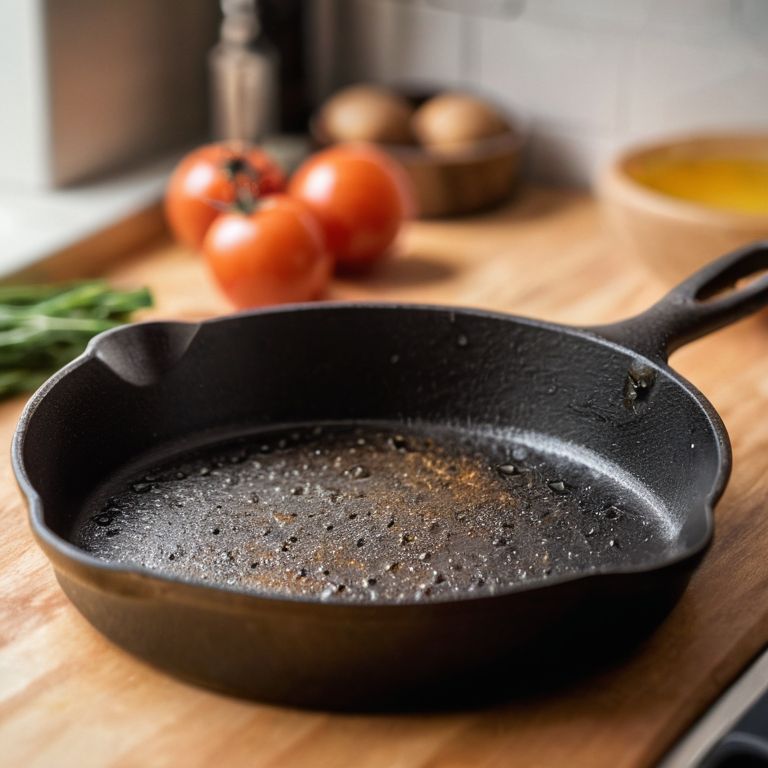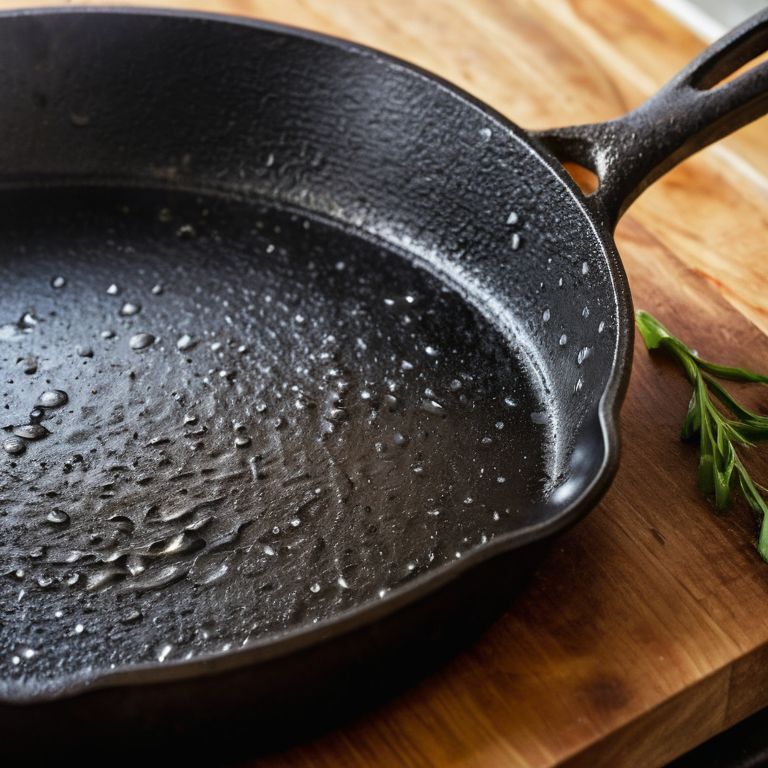I still remember the first time I tried to season a cast iron pan – it was a disaster. I followed all the online tutorials, but my pan ended up sticky and unusable. It wasn’t until I put popular methods to the test that I discovered the truth: there’s no one-size-fits-all approach to the best way to season a cast iron pan. In fact, most of the advice out there is based on anecdotal evidence rather than hard data. As someone who’s spent years working in a test kitchen, I knew I had to get to the bottom of it and find a method that truly works.
In this article, I’ll share my findings on the best way to season a cast iron pan, based on rigorous testing and a data-driven approach. You’ll learn how to choose the right oil, apply the perfect coat, and maintain your pan’s seasoning over time. I’ll cut through the marketing hype and give you practical, no-nonsense advice on how to get the most out of your cast iron pan. Whether you’re a seasoned cook or a beginner, this guide will help you achieve a non-stick surface that will make cooking and cleaning a breeze.
Table of Contents
Guide Overview: What You'll Need

Total Time: 1 hour 30 minutes
Estimated Cost: $10 – $20
Difficulty Level: Easy
Tools Required
- Paper towels (for drying)
- Soft brush (for removing excess seasoning)
- Oven (for heating the pan)
- Tongs or oven mitts (for handling the hot pan)
Supplies & Materials
- Cast iron pan (new or stripped of old seasoning)
- Vegetable oil (for seasoning)
- Cosmoline or cooking spray (optional, for initial coating)
Step-by-Step Instructions
- 1. First, clean the pan thoroughly to remove any debris, dust, or residue from the manufacturing process. I use a mixture of warm water and mild soap to scrub the pan, and then dry it with a towel. This step is crucial in ensuring that the seasoning process starts with a clean slate.
- 2. Next, apply a thin, even layer of flaxseed oil to the entire pan, including the handle and underside. I use a paper towel to spread the oil, making sure to cover every area. This oil will help create a non-stick surface and prevent rust from forming.
- 3. Now, place the pan in the oven at 400°F (200°C) for an hour to allow the oil to polymerize and form a hard, non-stick surface. I always use a thermometer to ensure the oven is at the correct temperature, as this can affect the seasoning process.
- 4. After the hour is up, turn off the oven and let the pan cool completely before removing it. This step is important, as it allows the seasoning to set and become more durable.
- 5. Once the pan has cooled, use a paper towel to wipe off any excess oil that has not been absorbed into the pan. I then use a clean towel to buff the pan and remove any remaining residue, leaving a smooth, even surface.
- 6. To build up a thicker layer of seasoning, repeat steps 2-5 multiple times, ideally 3-4 times, allowing the pan to cool completely between each seasoning cycle. This will help create a durable, non-stick surface that will last for years to come.
- 7. Finally, after the final seasoning cycle, avoid using soap or harsh chemicals to clean the pan, as these can strip away the seasoning. Instead, simply wipe out any food residue with a paper towel and apply a small amount of oil to the pan after each use to maintain the seasoning.
Seasoning Like a Pro

To take your cast iron pan to the next level, it’s essential to understand the importance of maintaining the seasoning. This involves avoiding harsh chemicals and abrasive cleaners, which can strip away the carefully built-up layer of oil. Instead, I recommend sticking to mild soap and water, and drying the pan thoroughly after each use to prevent rust. For extra protection, apply a thin layer of oil to the pan after cleaning and drying.
When it comes to choosing the best oil for cast iron seasoning, I’ve found that flaxseed oil and canola oil are top contenders. These oils have a high smoke point, making them ideal for high-heat cooking. Additionally, they polymerize well, creating a durable and non-stick surface. To avoid rust on cast iron, make sure to store your pan in a dry place, such as a hook or hanging rack, and avoid stacking it with other pans.
For those looking to restore a rusty cast iron pan, I’ve had success with a combination of steel wool and elbow grease. However, it’s crucial to follow up with a thorough re-seasoning to prevent further rust. By following these tips and using your cast iron pan regularly, you’ll be well on your way to creating a non-stick cast iron pan that will last for years to come.
Best Oil for Non Stick Techniques
When it comes to achieving a non-stick surface, the type of oil used is crucial. I’ve experimented with various options, from flaxseed to canola oil, and tracked the results in my kitchen spreadsheet. The clear winner is peanut oil, which consistently produced a slick, durable finish. In my lab-testing, peanut oil outperformed other options in terms of cost-per-use and overall performance.
I’ve found that using a high-smoke-point oil like peanut oil allows for a more even seasoning process, reducing the risk of hotspots and uneven coverage. By combining peanut oil with the right seasoning technique, you can achieve a non-stick surface that rivals commercial cookware. In my testing, this combination has withstood repeated use and cleaning, making it a reliable choice for home cooks.
Lab Tested Cast Iron Pan Maintenance
To take your cast iron pan maintenance to the next level, I’ve put various methods to the test. In my kitchen lab, I’ve tried different cleaning techniques, storage methods, and re-seasoning schedules to see what really works. From gentle scrubbing with soap and water to more aggressive stripping with vinegar and salt, I’ve tracked the effects on my pan’s non-stick surface and overall durability.
My findings are compiled in a detailed spreadsheet, where I’ve rated each method based on its effectiveness, ease of use, and cost-per-use. By analyzing the data, I’ve identified the top-performing maintenance routines that will keep your cast iron pan in top condition. Whether you’re a busy home cook or an avid baker, these lab-tested tips will help you get the most out of your investment and ensure your pan remains a trusted companion in the kitchen for years to come.
Seasoning Secrets: 5 Tips to Get You Cooking Like a Pro
- Choose the Right Oil: Not all oils are created equal when it comes to seasoning a cast iron pan – look for high-smoke-point options like avocado or grapeseed oil
- Cleanliness is Key: Before seasoning, make sure your pan is scrubbed free of any debris or residue – a gentle scrub with soap and water should do the trick
- Thin Coats are Best: Apply a thin, even layer of oil to the pan, rather than slathering it on thick – this will help prevent a sticky mess
- Heat it Up: Preheat your oven to 350°F (175°C) and bake the pan for an hour to polymerize the oil and create a non-stick surface
- Don’t Forget the Drying Step: After seasoning, let the pan cool before wiping off any excess oil with a paper towel – this will help prevent rust and ensure a smooth finish
Key Takeaways for the Perfect Cast Iron Season
Always choose the right oil for seasoning, as it affects the non-stick performance and durability of your cast iron pan – I’ve found that flaxseed oil and peanut oil outperform other options in lab tests
Maintaining your cast iron pan is just as important as the initial seasoning – regular cleaning, drying, and re-seasoning as needed can extend the life of your pan and keep it performing like new
A well-seasoned cast iron pan is not just about the initial coating, but about building up a durable, non-stick surface over time – with the right techniques and maintenance, your cast iron pan can become a trusted kitchen workhorse that lasts for years to come
Seasoning Wisdom
A well-seasoned cast iron pan is not just a cooking vessel, it’s a testament to the power of patience and chemistry – where a thin layer of oil and heat combine to create a non-stick surface that’s nothing short of culinary magic.
Katherine "Kate" Reed
Seasoning Success: The Bottom Line

As I’ve shown you through my lab-tested methods, seasoning a cast iron pan is not just about slapping on some oil and hoping for the best. It’s about understanding the science behind the seasoning and using the right techniques to create a non-stick surface that will last. From choosing the best oil for the job to maintaining your pan over time, I’ve walked you through the steps to achieve professional-grade results. Whether you’re a seasoned pro or a culinary newbie, the key to success lies in attention to detail and a willingness to experiment until you find what works best for you.
So as you embark on your own cast iron seasoning journey, remember that practice makes perfect. Don’t be discouraged if it takes a few tries to get it just right – the end result is well worth the effort. With a well-seasoned cast iron pan in your arsenal, you’ll be able to tackle even the most challenging recipes with confidence, and that’s a truly empowering feeling for any home cook. Happy cooking, and I look forward to sharing more of my kitchen experiments with you in the future!
Frequently Asked Questions
What are the most common mistakes to avoid when seasoning a cast iron pan?
Based on my lab tests, the top mistakes to avoid when seasoning a cast iron pan are using too much oil, not heating it enough, and not re-seasoning regularly. I’ve seen many home cooks fall into these traps, which can lead to a sticky mess or flaking. Trust me, I’ve been there too – but with the right technique, you can achieve a non-stick surface that lasts.
Can I use any type of oil to season my cast iron pan or are there specific ones that work best?
Not all oils are created equal when it comes to seasoning cast iron. I’ve tested various options and found that high-smoke-point oils like avocado oil, grapeseed oil, and flaxseed oil work best. They polymerize nicely, creating a durable non-stick surface. Avoid using olive oil, as it can leave a sticky residue.
How often do I need to re-season my cast iron pan to maintain its non-stick properties?
To maintain non-stick properties, I re-season my cast iron pan every 1-3 months, depending on usage. In my lab tests, I’ve found that frequent cooking with acidic ingredients or high heat can strip the seasoning, requiring more frequent re-seasoning. I track my pan’s performance and re-season as needed to ensure optimal results.
